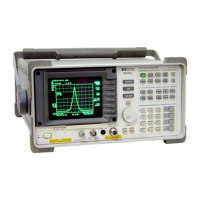Third-Order Intermodulation Distortion
Two-tone, third-order intermodulation distortion is a common problem in communication
systems. When two signals are present in a system, they can mix with the second harmonics
generated and create third-order intermodulation distortion products, which are located close
to the original signals. These distortion products are generated by system components such as
amplifiers and mixers.
Example: Test a device for third-order intermodulation. This example uses two sources, one
set to 300 MHz and the other to approximately 301 MHz. (Other source frequencies may be
substituted, but try to maintain a frequency separation of approximately 1 MHz.)
1. Connect the equipment as shown in Figure 3-24.
Figure 3-24. Third-Order Intermodulation Equipment Setup
2. Set one source to 300 MHz and the other source to 301 MHz for a frequency separation of
1 MHz. Set the sources equal in amplitude (in this example, the sources are set to -5
dBm)
3. Tune both signals onto the screen by setting the center frequency between 300 and
301 MHz. Then, using the knob, center the two signals on the display. Reduce the frequency
span to 5 MHz for a span wide enough to include the distortion products on the screen. To
be sure the distortion products are resolved, reduce the resolution bandwidth until the
distortion products are visible. Press
(BW),
RES BW , and then use the step-down key
((J-J)
to
reduce the resolution bandwidth until the distortion products are visible.
4. For best dynamic range, set the mixer input level to -40
dBm
and move the signal to the
reference level: press
C-1,
More 1 of 3 , MAX MXR LEVEL , 40
m.
The spectrum analyzer automatically sets the attenuation so that a signal at the reference
level will be a maximum of -40 dBm at the input mixer.
5. To measure a distortion product, press
[PEAK
SEARCH)
to place a marker on a source signal.
To activate the second marker, press MARKER A . Using the knob, adjust the second marker
to the peak of the distortion product that is beside the test tone. The difference between
the markers is displayed in the active function block.
3-22 Making Basic Measurements

